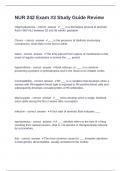NUR 242 Exam #3 Study Guide Review
Oligohydramnios - correct answer ✔___ is a decreases amount of amniotic
fluid (<500 mL) between 32 and 36 weeks' gestation.
Clonus - correct answer ✔___ is the presence of rhythmic involuntary
contractions, most often in the foot or ankle.
latent - correct answer ✔The time interval from rupture of membranes to the
onset of regular contractions is termed the ___ period.
hyperreflexia - correct answer ✔Brisk reflexes, or ___, is a common
presenting symptom of preeclampsia and is the result of an irritable cortex.
incompatibility - correct answer ✔Rh ___ is a condition that develops when a
woman with Rh-negative blood type is exposed to Rh-positive blood cells and
subsequently develops circulating titers of Rh antibodies.
Monozygotic - correct answer ✔___ twins develop when a single, fertilized
ovum splits during the first 2 weeks after conception.
infection - correct answer ✔A foul odor of amniotic fluid indicates ___.
spontaneous - correct answer ✔A ___ abortion refers to the loss of a fetus
resulting from natural causes---that is, not elective or therapeutically induced
by a procedure.
first - correct answer ✔The most common cause for ___ trimester abortions
is fetal genetic abnormalities, usually unrelated to the mother.
,Gestational - correct answer ✔___ hypertension is characterized by
hypertension without proteinuria after 20 weeks' gestation and a return of the
blood pressure to normal postpartum.
Loss of an early pregnancy, usually before the 20th week of gestation. -
correct answer ✔Spontaneous abortion
Pregnancy in which the fertilized ovum implants outside of the uterine cavity. -
correct answer ✔Ectopic pregnancy
Spectrum of neoplastic disorders that originate in the human placenta. -
correct answer ✔Gestational trophoblastic disease
Weak, structurally defective cervix that spontaneously dilates in the absence
of contractions in the second trimester, resulting in the loss of pregnancy. -
correct answer ✔Cervical insufficiency
Painless bleeding condition that occurs in the last two trimesters of
pregnancy. - correct answer ✔Placenta previa
1. Place the woman in the supine position
2. Have the woman flex her knee slightly
3. Place a hand under the knee to support the leg and locate the patellar
tendon
4. Using a reflex hammer or the side of the hand, strike the area of the patellar
tendon firmly and quickly
5. Note the movement of the leg and foot
6. Repeat the procedure on the opposite leg - correct answer ✔Steps for
assessing the patellar reflex
, Dehydration, electrolyte imbalance, ketosis, malnutrition, persistent,
uncontrollable nausea, acid-base imbalances, and weight loss. If the condition
persists and is allowed to continue, it jeopardizes fetal well-being. - correct
answer ✔What are some of the possible complications of hyperemesis
gravidarum?
Spontaneous early abortion, uterine fibroids, ectopic pregnancy, GTD, and
cervical insufficiency. - correct answer ✔What are the conditions associated
with early bleeding during pregnancy?
The journey is arrested or altered in some way; physical blockage, failure of
the tubal epithelium to move the zygote down the tube into the uterus, tubal
scarring d/t PID, Neisseria gonorrhea, chlamydia trachomatis, previous tubal
surgery, infertility, PID, previous pregnancy loss, use of IUD, previous ectopic
pregnancy, uterine fibroids, sterilization, smoking, history of multiple sexual
partners, use of progestin-only oral contraceptives, douching, and exposure to
DES. - correct answer ✔What are the causes of ectopic pregnancy?
Previous pregnancy complicated by hyperemesis, molar pregnancies, history
of helicobactor pylori infection, multiple gestation, pregnancy with history of
genitourinary disorder, clinical hyperthyroid disorders, and pre-pregnancy
psych diagnosis. - correct answer ✔What are the risk factors for
hyperemesis gravidarum?
Reduce risk factors such as sexual intercourse with multiple partners, avoid
contracting an STI which leads to PID, obtain early diagnosis and treatment of
STI, with IUD descriptions of the s/s of PID should be included to reduce the
risk of repeat ascending infections which can be responsible for tubal scarring,
avoid smoking, use condoms, seek prenatal care early. - correct answer
✔What should a nurse include in prevention for ectopic pregnancies?




